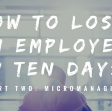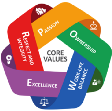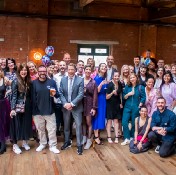More than Just a Number: Personalisation vs Parity
Part 3: Research and insights deep dive on the topics keeping leaders up at night, from the team at Magnetic. we’re shining a light on employee tensions — check our part 1 and part 2 of our Thought Report before you dive into Part 3 below. (Rather view the Thought Report as pdf? Download your free copy here.)
While flexibility looks at the question of autonomy around working habits, it is part of a bigger emerging tension concerning personalisation. People are demanding more individuality. ‘Don’t treat me like everyone else. My needs are uniquely different from those of my colleagues.’ Here again, though, companies are pitched into conflict with the basic principles of fairness and consistency. How can management create parity when everyone is calling for personalisation?
Personalisation is, bluntly, the buzziest of buzz words, yet for all its ubiquity in e-commerce, social media, and even the wellness space, what personalisation actually means in the context of the employee experience is still murky.
There seems to be a trend in the literature around the topic that platform-driven data solutions are key to cracking personalisation. If granular data enabled customers to enjoy Amazon recommendations or the algorithms that run Tik-Tok, why can’t it be used to create the best, most bespoke employee experience. It’s a clean idea but does not go far in solving the tensions we’re talking about here. HR systems and apps scrape personalised data and can keep a track of performance or habits, but it would be a stretch to suggest that they singularly meet personalised expectations to the depth or care that employees want, and it does little to tackle the fairness question. How can that data truly ensure that all employees are treated fairly and consistently in line with their differences? How can it avoid dehumanising them as a series of data points?
We’re not being cynical. There are many brilliant examples of fascinating innovations in the personalised EX space. Take something like YuLife’s gamified approach to benefits, for example, or platforms that would be able to curate company news, uncover upskilling opportunities, or tailor re-onboarding experiences for after maternity leave. Incredible stuff, but the point is that they are tools to help facilitate the evolution and reinvention of the employee experience. They are a means to a guiding principle, and that principle, quite simply, is that your employees are your customers.
This quote from Liz Sebag-Montefiore, co- founder of career management specialist 10Eighty summarises the point beautifully:
“think of employees as customers; consider their values, needs and preferences. Consider that an organisation’s ability to make employees more employable will become a point of competitive advantage.”
I’ve hinted at this perspective at the very start of this piece: our clients are pivoting their focus from customers to employees. The desire to use innovation to uncover customer needs, conceptualise solutions and add value to end users remains the same, it’s just the end user that has changed.
A case study from the Magnetic vaults: Mars
Mars is the world’s biggest family owned firm. They have over 140,000 employees and amass annual revenues of over $45bn. They’re now even bigger than Coca-Cola and Unilever — and interestingly they make more money from pet food and pet care than chocolate. The firm asked us to review the employee experience with them during the pandemic, certain that COVID would change the way they worked forever. They weren’t crystal clear on the solution, other than they’d need to think differently, disregard the assumptions of the past and innovate to create an entirely new employee experience.
As with Bupa, we used a human centric approach to build a new model that optimised ways of working, and set the scene for a new era of leadership that would embed a more personalised experience.
Here’s what we did:
- We developed the Mars Future of Work Deployment Kit, a toolkit that was distributed across different regions and segments.
- This did not entail a standardised approach, in fact far from it. The Kit guides teams and managers to rethink the employee experience based on their specific needs, fed by input from every member of the team, while still maintaining a OneMars approach, anchored in the business purpose and Five Principles.
- The Kit identifies four priority areas to rethink: hybrid working, office, travel and meetings. Each priority area represented an opportunity for teams to personalise their approach to work. Perhaps a team might collectively decide to ban meetings past 3pm, or create a ‘remote-by-default’ policy.
- The kit contains all the resources, information, tools, templates and links to help managers and their teams understand how they can adopt new behaviours and embrace new ways of working to activate the change.
Personalisation therefore becomes an exercise in radical empathy towards your employees. When viewed in this way, fairness and consistency become integral to the conversation. Serving the needs of one part of the workforce at the expense of another will not work, and be quickly identified as a problem to solve if approaching employee experience from a customer-centric perspective.
Being close to your people’s needs, and doing so consistently, is a difficult task, bound to be riddled with plenty of false-starts, mistakes and u-turns. However, it is through this iterative process of being empathetic to the personal needs of employees that this tension can be balanced.
This is the third part in our series of articles breaking down this huge topic. Follow us for more on the four key tensions. (Rather view the full Thought Report as pdf? Download your free copy here.)
Magnetic is a design and innovation company that helps design better futures. We’ve worked with global businesses to build capabilities, products, services and transform organisations. To find out more, get in touch: hello@wearemagnetic.com.






